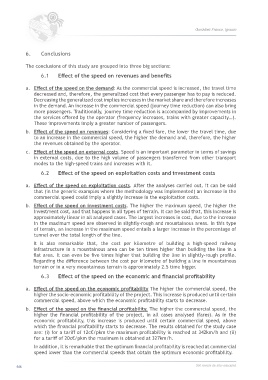Page 548 - 360.revista de Alta Velocidad - Nº 6
P. 548
González Franco, Ignacio
6. Conclusions
The conclusions of this study are grouped into three big sections:
6.1 Effect of the speed on revenues and benefits
a. Effect of the speed on the demand: As the commercial speed is increased, the travel time
decreased and, therefore, the generalized cost that every passenger has to pay is reduced.
Decreasing the generalized cost implies increases in the market share and therefore increases
in the demand. An increase in the commercial speed (journey time reduction) can also bring
more passengers. Traditionally, journey time reduction is accompanied by improvements in
the services offered by the operator (frequency increases, trains with greater capacity…).
These improvements imply a greater number of passengers.
b. Effect of the speed on revenues: Considering a fixed fare, the lower the travel time, due
to an increase in the commercial speed, the higher the demand and, therefore, the higher
the revenues obtained by the operator.
c. Effect of the speed on external costs. Speed is an important parameter in terms of savings
in external costs, due to the high volume of passengers transferred from other transport
modes to the high-speed trains and increases with it.
6.2 Effect of the speed on exploitation costs and investment costs
a. Effect of the speed on exploitation costs. After the analyses carried out, it can be said
that (in the generic examples where the methodology was implemented) an increase in the
commercial speed could imply a slightly increase in the exploitation costs.
b. Effect of the speed on investment costs. The higher the maximum speed, the higher the
investment cost, and that happens in all types of terrain. It can be said that, this increase is
approximately linear in all analysed cases. The largest increases in cost, due to the increase
in the maximum speed are observed in slightly-rough and mountainous areas. In this type
of terrain, an increase in the maximum speed entails a larger increase in the percentage of
tunnel over the total length of the line.
It is also remarkable that, the cost per kilometre of building a high-speed railway
infrastructure in a mountainous area can be ten times higher than building the line in a
flat area. It can even be five times higher that building the line in slightly-rough profile.
Regarding the difference between the cost per kilometre of building a line in mountainous
terrain or in a very mountainous terrain is approximately 2.5 time bigger.
6.3 Effect of the speed on the economic and financial profitability
a. Effect of the speed on the economic profitability The higher the commercial speed, the
higher the socio-economic profitability of the project. This increase is produced until certain
commercial speed, above which the economic profitability starts to decrease.
b. Effect of the speed on the financial profitability. The higher the commercial speed, the
higher the financial profitability of the project, in all cases analysed (fares). As in the
economic profitability, this increase is produced until certain commercial speed, above
which the financial profitability starts to decrease. The results obtained for the study case
are: (i) for a tariff of 12c€/pkm the maximum profitability is reached at 342km/h and (ii)
for a tariff of 20c€/pkm the maximum is obtained at 327km/h.
In addition, it is remarkable that the optimum financial profitability is reached at commercial
speed lower than the commercial speeds that obtain the optimum economic profitability.
546 360.revista de alta velocidad

